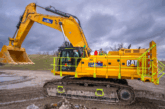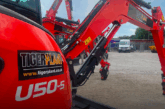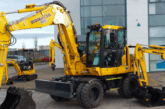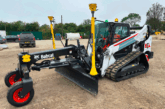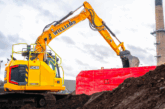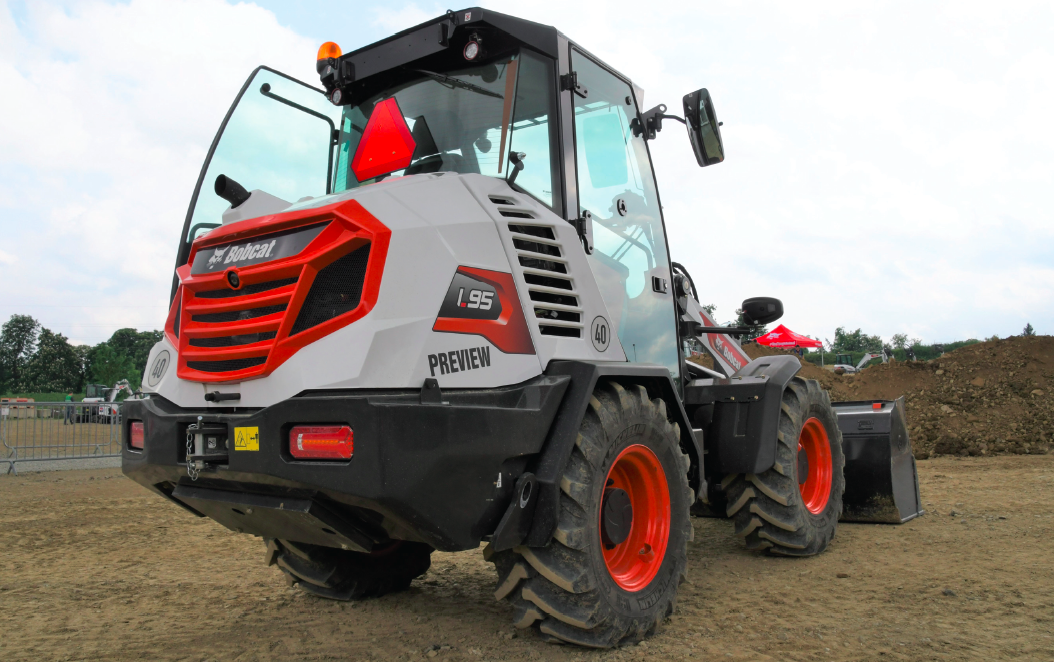
With the festive season over he’s itching to get back to work. Some say he thinks that lunch is for wimps, others that he enjoys nothing more than a sandwich in the cab. All we know is that we call him The Dig. This month he gets his claws into a Bobcat CWL.
Compact wheeled loaders (CWL) may be relatively small in stature, but they are definitely big business from a manufacturer’s and end user’s perspective. For those of you interested in such things, the demand, according to industry research, in the compact wheeled loader market is anticipated to top US$ 6.64bn, growing at a compound annual growth rate (CAGR) of 3.3% up to 2029.
Europe has long been the most lucrative market for these extremely versatile machines/tool carriers, accounting for nearly 43.7% of the global demand up to 2022 andthis growth is expected to continue in the coming years.
Bobcat is one manufacturer who is keen to expand its market share in this sector. To date it has launched the L85 model in ‘advanced’ configuration, tipping the scales at 5.1-tonnes and fitted with a 68hp diesel engine; it was the company’s first designed and built CWL. Then it added the L75 ‘value’ model weighing in at a modest 4.6-tonnes and powered by 55hp diesel engine, with both models sporting a standard bucket capacity of 0.8 m3.
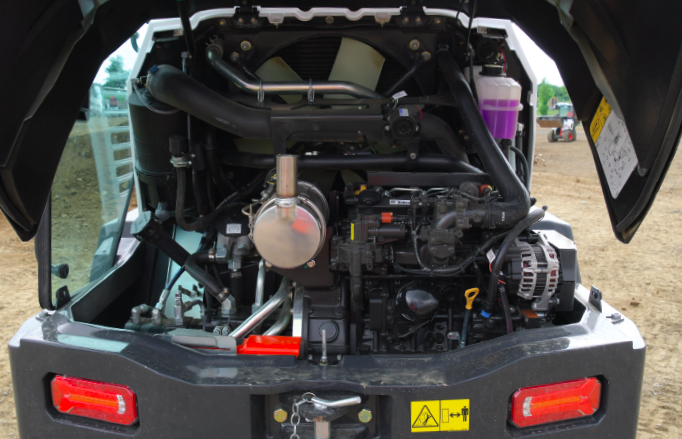
So, when I had the chance to get up close and personal with Bobcat’s largest CWL to date, the L95 ‘premium’ model, I naturally jumped at the chance. The machine shares the same dynamic styling as its siblings, has an operating weight of 5.4 tonnes, and is powered by a Stage V emissions-compliant Bobcat diesel engine producing 75hp @2600rpm. Before I got behind the wheel for this test drive opportunity, I took a little walk-around the machine. Starting at the rear, popping the large and stylish shaped one-piece bonnet reveals superb access to all the engine components for daily checks and routine servicing. This model also benefits from a larger and heavier counterweight which helps to increase the shovel’s lifting capacity with a specified bucket tipping load of 3339kg. It is shod with the much-lauded Michelin XMCL 400/70 R20 IMD tyres, but different options are available to suit customer’s requirements.
The loader is the classic design of cab and engine to the rear and loader arms on the front ahead of the articulation point, which when operating feels a lot more logical than on some small compact loaders where the cab is mounted on the front section of the chassis, which is fine, but can take some getting used to. The loader arms themselves feature twin lifting rams nicely installed on the inside frame, the single ram for the bucket tipping function forms part of a classic Z-bar linkage, which is well proven in wheeled loader design. Our demo machine was sporting a larger than standard 1m3 bucket, mounted on the Bobcat’s Power Quick-Tach attachment pick up system, which has been redesigned to simplify and protect the hydraulic connections from any potential damage.
Using this system end users can share Bob- Tach attachments on the job site with skid. steer loaders and compact track loaders, further enhancing versatility. Standard flow hydraulics are fitted as the name suggests, as standard, to power such work tools as a combination bucket, angle broom, and sweeper, but this example was fitted with high flow auxiliary hydraulics, with quick connect couplers mounted on the inside of the nearside loader arms. Keeping in line with other Bobcat loaders the high flow system provides 100 l/m to feed those really oil hungry attachments such as planers, flail mowers, cutting wheels and snow blowers; to improve the high flow attachment performance the pressure has been increased from 200 to 225 bar.
The finer details
Access and egress to the FOPS level II approved cab is easy, the door opening is vast, and convenient grab handles are well located to ensure that all important three points of contact when getting onboard and leaving.
The front screen is slightly curved back which I discovered allows a much better view of the bucket when raised high, for example when loading a truck or a material hopper, without the need to lean your head forward to gain a better view, every little detail appears to have been designed around the operator to provide a more comfortable operating experience.
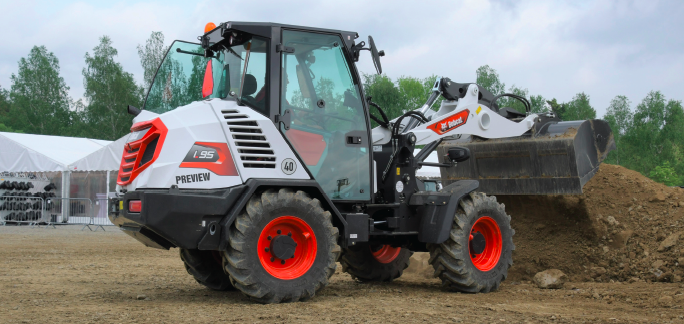 The fully adjustable, air suspended seat, also features the integrated multi-function joystick which rises and falls with the operator when travelling over rough terrain, ensuring maximum comfort and most importantly full control at all times.
The fully adjustable, air suspended seat, also features the integrated multi-function joystick which rises and falls with the operator when travelling over rough terrain, ensuring maximum comfort and most importantly full control at all times.
The joystick itself has been improved, to make it easy to use and comfortable to operate with, with switches and buttons ergonomically placed. The direction of travel rocker switch for instance is located on the front of the joystick and is operated by your index finger. Raising the loader arms and tipping the bucket, all follow the industry standard operation and is very intuitive in function.
On the top of the joystick, we find buttons for the diff-lock, low and high-speed selection (tortoise and rabbit) loader arm float function, and auxiliary flow control. To the operator’s right there are three banks of soft switches for a multitude of functions including lights, windscreen wipers, flashing beacon and even heated seat to name a few, next to the ignition key we have the air-conditioning controls. A rotary hand throttle dial is also provided for those who prefer not to use the more familiar foot pedal throttle. Storage space and a 12v charging point is also provided for that all important mobile phone charging.
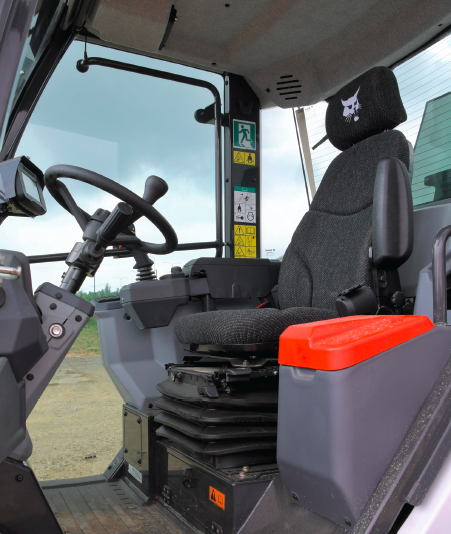
The steering wheel is adjustable for reach and rake for the ultimate in operating comfort, although it’s something I forgot to do, when in my haste, I went on to use the machine in the demo area!
I really love the simplicity of the cabin, it’s all very clean cut, workmanlike and user friendly. The 5in display screen is minimal but extremely practical and doesn’t obscure your vision, it also doubles up as the reversing camera screen, which is automatically engaged when reverse gear is selected. A familiar jog dial as we so often see in modern hydraulic excavators, is used to access the various menus where the operator can find a lot of information on the machine’s status and such things as, auto idle, auto ride control and hydraulic oil flow settings.
Having settled in the new cloth seat and adjusted the arm rests, and popped on my lap belt, it was time to give the machine a bit of a workout on the demo plot. A traditional ignition key is fitted to start up the machine, but during the working day you can use the green and red soft-touch buttons on the righthand console, as a quick and easy start and stop process.
I opted to use the foot pedal throttle, but as previously mentioned you can change the engine’s rpm using Bobcat’s flex drive feature, using the rotary throttle dial if desired, which can help to speed up the working operation of the machine depending on application. When using this feature the auto-idle function is activated which automatically drops the engine revs down to idle after a period of four seconds of inactivity, thus reducing fuel consumption. The machine features a two-speed electronically controlled hydrostatic transmission and has a top speed on this model of 40 km/h, but in this application, I was only ever going to need first gear. The machine had plenty of grunt and breakout force as I dove the shovel into the pile of dirt, curling back the bucket as I powered forward to retain the spoil within.
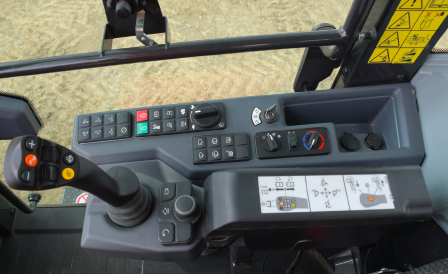
Selecting reverse on the joystick with my index finger, I instantly noticed the rear camera view pop up on the screen, but my old school ways still prompted me to look over my shoulder through the large rear screen.
I shifted a number of buckets about and was very impressed with the ride quality for myself and of the overall stability of the machine, even with an overflowing bucket of heavy clay at full height, the machine remained stable. The bucket level indicator located on the bucket cylinder offers good feedback, letting you know that the bucket is level when going into the heap to prevent premature ride up the pile, often a mistake with novice shovel operators.
This is a lively compact loader at the larger end of the scale, very quick, nimble and powerful, not something I drive very often to be honest, but from my experience on this one, I would be quite happy to spend a few shifts on it, I couldn’t fault it in any way.

